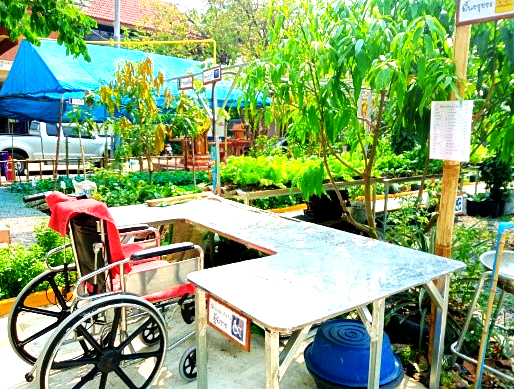Knowledge Management Guideline of Agricultural Process Innovation for Elderly’s Wellbeing in Krainok Elders School, Sukhothai Province
Main Article Content
Abstract
The elderly in Krainok subdistrict, Sukhothai province had pesticide contaminated in the blood, could not access safe food, and had physical limitations in framing. So this participatory action research aims to develop knowledge management guidelines to search for agricultural process innovation the wellbeing for the elderly at the Krainok Elders School by using the SECI Model knowledge management framework, consists of 4 steps as follows: 1) the socialization step was to search for network partners jointly, to study and analyze data on agricultural forms and suitable technologies for the elderly; 2) the externalization step was to study the guidelines of knowledge management of agricultural process innovation for the elder’s people’s wellbeing into manual, curriculum, demonstration plots, and resource person; 3) the combination and internalization steps were to improve the potential of the elderly according to knowledge management approaches by curriculum and supportive resources developed; 4) Assessment step was to evaluate and lesson learns. The learning outcomes from the curriculum revealed that the elderly was inspired to do by the Good Agricultural standard. They had learnt and understood in safety production, marketing and sharing knowledge with the elderly in neighboring sub-districts. The results by self-assessment were as follows; overall of the elderly’s opinions and cognition to the agricultural innovation in 4 dimensions at the highest level; in health, mentality, social, and intellectual. In addition, the research found approximately 17.58% grew their own vegetables after participating in the project. They could reduce household expenses about 812.20 baht/month/household. The results of lessons learned found that older people could access to more safe food, learn to work in suitable plant plots for their own physical condition and safe farming. They could exchange and learn together, reduce stress, and proud to be as a giver of safety food to their community.
Article Details

This work is licensed under a Creative Commons Attribution-NonCommercial-NoDerivatives 4.0 International License.
Area Based Development Research Journal values copyright protection and licensing to safeguard author rights and facilitate the appropriate dissemination of research. Our policies ensure openness, accessibility, and attribution. Authors retain copyright ownership, and articles are published under a Creative Commons Attribution License (CC BY), allowing sharing, adaptation, and proper attribution. Authors have the freedom to publish under the CC BY license, granting broad reuse and distribution permissions. The journal supports posting articles on third-party repositories, adhering to institutional and funding restrictions. Author guidelines detail copyright and licensing requirements, empowering authors with knowledge about their rights and responsibilities. These policies cultivate an environment of collaboration, openness, and responsible sharing, benefiting authors and the research community while honoring intellectual property rights.
References
Centre for Excellence in Universal Design. (2020). The 7 Principles. Retrieved July 5, 2020, from: http://universaldesign.ie/What-is-Universal-Design/The-7-Principles/.
Chutapruttikorn, R. (2018). UD home: Architectural learning integration through social service project. Journal of Environmental Design, 5(2), 83-99. (in Thai).
Chumtakhob, D. (2020). Sufficiency economy: An alternative survival strategy for the COVID-19 pandemic. Journal of Multidisciplinary Academic Research and Development, 2(3), 11-22. (in Thai).
IAASTD. (2009). Agriculture at crossroads - Global report. Retrieved July 7, 2020, from: https://wedocs.unepr.org/handle/20.500.11822/9569.
Ikujiro, N., & Takeuchi, H. (1995). The knowledge creating company: How Japanese companies create the dynamics of innovation. New York: Oxford University Press.
Inthaphan, C. (2018). Guidelines for social innovation for the elderly using social capital in the area of local administrative organizations in Ubon Ratchathani province. (Research report). Faculty of Political Science, Ubon Ratchathani University. (in Thai).
Jarutat, J., & Sansanaweerakul, C. (2015). Universal design: Concept of design for all. Real Estate Information Center Journal by GH Bank, 21(80), 40-47. (in Thai).
Jitsuchon, S. (2019). Thailand’s sufficiency economy philosophy as an alternative path to sustainable development. European Journal of Sustainable Development, 8(2), 191-200.
Kadir, A., & Jamaludin, M. (2013). Sustainable life and social development through universally designed environment. Asian Journal of Environment-Behaviour Studies, 3(9), 1-10.
Kasikorn Research Center. (2021). Are Thai ready for hyper aging society?. Retrieved August 15, 2021, from: https://kasikornresearch.com/th/analysis/k-social-media/Pages/Aging-society-FB-30-04-21.aspx.
Krinok Subdistrict Administrative Organization. (2019). Annual report of Krinok subdistrict administrative organization. Sukhothai:Krinok Subdistrict Administrative Organization. (in Thai).
National Bureau of Agricultural Commodity and Food Standards. (2009). Good agricultural practices for food crop: Thai Agricultural Standard TAS 9001-2009. Bangkok: National Bureau of Agricultural Commodity and Food Standards. (in Thai).
Noulsri, A. (2019). Aging society and labor agriculture sector of Thailand. Retrieved September 16, 2019, from: http://wiki.ocsc.go.th/_media/514.pdf. (in Thai).
Office of the National Economic and Social Development Council, (n.d.). What is the sufficiency economy philosophy?. Retrieved June 25, 2020, from: https://www.nesdc.go.th/ewt_w3c/ewt_dl_link.php?filename=suffic ienteconomy&nid=9202. (in Thai).
Praisin, A., Wannakayont, A., & Ruangreung, L. (2020). House design for elderly and mobility disable based on universal design concept. Journal of MCU Nakhondhat, 7(11), 299-313. (in Thai).
Poungngam, K. (2015). Local innovation of local government organization. Bangkok: Kematham (in Thai).
Rice, J., & Rice, B. (2002). The applicability of the SECI model to multi-organisational endeavours: An integrative review. International Journal of Organizational Behaviour, 9(8), 671-682.
Sirikesorn, L. (2021). Development of safe green produce grower group of smallholder farmers in Phranakorn Si Ayutthaya, Bang Ban, and Bang Pahan districts, Phra Nakhon Si Ayutthaya province. Area Based Development Research Journal, 13(4), 234-250. (in Thai).
Sriko, T. (2021). Model of curriculum and elderly teaching learning management in innovation creativity era (Romsamohvittaya School) Mueang district, Phitsanulok. Journal of Legal Entity Management and Local Innovation, 7(9), 207-220. (in Thai).
Tamdee, D., Suwanaprapisa, T., & Senaratra, W. (2013). Knowledge management and knowledge creation for healthy community in Lower- Northern Thailand. Nursing Journal, 40(4), 100-113. (in Thai).
Wutthirong, P. (2010). Innovation and Thailand’s competitiveness: The next step towards creative economy. Chulalongkorn Review, 22(86), 43-67. (in Thai).


